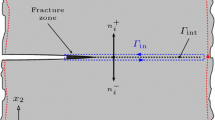Abstract
A new constant displacement discontinuity (CDD) element is presented for the numerical solution of Mode I, II and III crack problems, based on the strain-gradient elasticity theory in its simplest possible Grade-2 (second gradient of strain or G2 theory) variant. The accuracy of the proposed new element is demonstrated herein in a first attempt only for isolated straight cracks or for co-linear straight cracks for which closed form solutions exist. It is shown that the results based on this new element are in good agreement with the exact solutions. Moreover, the new method preserves the simplicity and hence the high speed of the CDD method originally proposed by Crouch with only one collocation point per element for plane crack problems, but it is far more efficient compared to it, especially close to the crack tips where the displacement and stress gradients are highest.
Similar content being viewed by others
References
Vardoulakis I, Exadaktylos G, Aifantis E (1996) Gradient elasticity with surface energy: Mode III crack problem. Int J Solids Struct 33(30): 4531–4559
Exadaktylos G, Vardoulakis I, Aifantis E (1996) Cracks in gradient elastic bodies with surface energy. Int J Fract 79: 107–119
Exadaktylos G, Aifantis E (1996) Two and three dimensional crack problems in gradient elasticity. J Mech Beh Mtls 7(2): 93–117
Exadaktylos G (1998) Gradient elasticity with surface energy: Mode-I crack problem. Int J Solids Struct 35(5–6): 421–456
Exadaktylos GE (1999) Some basic half-plane problems of the cohesive elasticity theory with surface energy. Acta Mech 133(1–4): 175–198
Exadaktylos GE, Vardoulakis I (2001) Microstructure in linear elasticity and scale effects: a reconsideration of basic rock mechanics and rock fracture mechanics. Tectonophysics 335(1–2): 81–110
Crouch SL (1976) Analysis of stresses and displacements around underground excavations: an application of the displacement discontinuity method. University of Minnesota Geomechanics Report, Minneapolis, Minnesota, November, 1976
Crouch SL (1976) Solution of plane elasticity problems by the displacement discontinuity method. Int J Numer Method Eng 10: 301–343
Crouch SL, Starfield AM (1990) Boundary element methods in solid mechanics. Unwin Hyman, Boston
Schultz RA (1988) Stress intensity factors for curved cracks obtained with the displacement discontinuity method. Int J Fract 37: R31–R34
Guo H, Aziz NI, Schmidt LC (1990) Linear elastic crack tip modelling by the displacement discontinuity method. Eng Fract Mech 36: 933–943
Yan X (2004) A special crack tip-displacement discontinuity element. Mech Res Commun 31: 651–659
Scavia CA (1992) A numerical technique for the analysis of cracks subjected to normal compressive stresses. Int J Numer Method Eng 33: 929–942
Wiles TD, Curran JH (1982) A general 3-D displacement discontinuity method. In: Proceedings of 3rd international conference on numerical method geomechanics, pp 103–111
Sneddon IN, Lowengrub M (1969) Crack problems in the classical theory of elasticity. Wiley, New York
Crawford AM, Curran JH (1982) Higher-order functional variation displacement discontinuity elements. Int J Rock Mech Min Sci Geomech Abstr 19: 143–148
Shou KJ, Crouch SL (1995) A higher order displacement discontinuity method for analysis of crack problems. Int J Rock Mech Min Sci Geomech Abstr 32(1): 49–55
Mindlin RD (1965) Second gradient of strain and surface-tension in linear elasticity. Int J Solids Struct 1: 417–438
Sih GC (1964) Boundary problems for longitudinal shear cracks. In: Proceedings, second conference on theoretical and applied mechanics. Pergamon Press, New York, 117 pp
Gradshteyn IS, Ryzhik IM (1980) In: Jeffrey A (ed) Tables of integrals, series, and products. Corrected and enlarged edition. Academic Press, New York
Kröner E (ed) (1967) Mechanics of generalised continua. Spinger-Verlag, Berlin
Author information
Authors and Affiliations
Corresponding author
Rights and permissions
About this article
Cite this article
Exadaktylos, G., Xiroudakis, G. A G2 constant displacement discontinuity element for analysis of crack problems. Comput Mech 45, 245–261 (2010). https://doi.org/10.1007/s00466-009-0440-1
Received:
Accepted:
Published:
Issue Date:
DOI: https://doi.org/10.1007/s00466-009-0440-1



